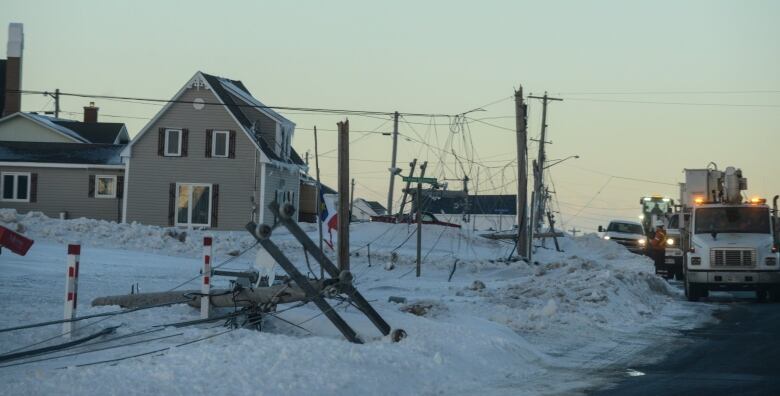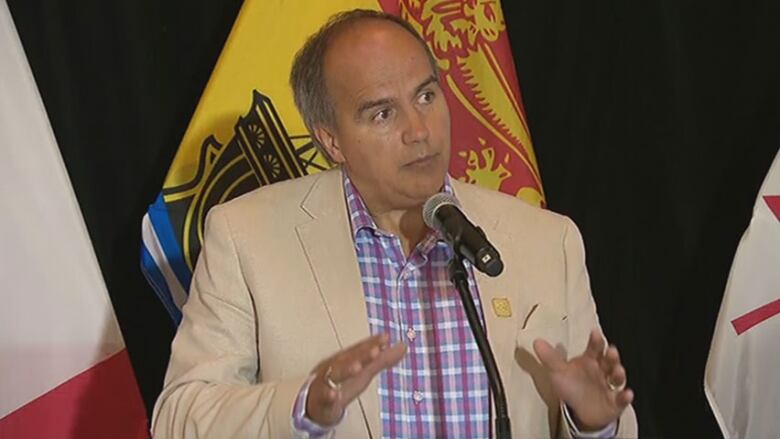EMO staffing 'grossly inadequate' during devastating ice storm, report finds
Review of 2017 storm makes 51 recommendations, including 911 fee hike, more carbon monoxide detectors

The New Brunswick government should increase funding for emergency services,andthe Emergency Measures Organization should add more regional emergency management co-ordinators"as soon as possible," areview of last winter's "catastrophic" ice storm recommends.
The January 2017 ice storm reportwasreleased Fridaymorning in Neguacby Judy Wagner, clerk of the executive council and the government's highest-ranking civil servant.
There's a lot of work to go to get us to where we want to be.- Judy Wagner, executive council clerk
It makes 51 recommendationsaimed at strengthening the government's future responses to natural disasters and emergencies like the three-day ice storm that caused widespread power outages and claimed two lives.
No timelines or costs are provided.
"There's a lot of work to go to get us to where we want to be," Wagner told reporters. "Preparedness and planning is going to be the key to all this," not just on the government's part, but citizens' as well, she said.
- When brutal storms strike, some rural areas can't cope, municipalities say
- Public 'disappointed' in NB Power's response during 2017 ice storm
- Ice storm cleanup bill biggest in NB Power history at $30M
"Citizens must take greater responsibility for the preparedness of themselves and their families, and not assume that institutional services (i.e., government or other relief organization) will be in place as quickly as desired to maintain their safety and comfort," the 163-page report says.
Only about 47 per cent of households have the recommended72-hour emergency kit, said Wagner, who held public meetings in Bas-Caraquet, Lamque, Miramichi, Richibucto and Tracadie in April as part of thereview.
Fear of crime
"One of the most surprising and unfortunate" findings of the review was that fear of becoming a victim of crime put some people at greater risk.
People were more inclined to use their generators in sheltered, poorly ventilatedareas, such as garages,amid rumours of generators being stolen, which contributed to numerous cases of carbon monoxide poisoning, it said, although no statistics on the actual number of thefts that occurred are available.
People who felt vulnerable were also less inclined to open their doors to those conducting door-to-door wellness checks, and less inclined to leave their homes to seek shelter in a better-equipped location, such as one of the warming centres.
Improve restoration estimates

The storm, which startedin southern New Brunswick on Jan. 24 and spread to the northeast, knockedout power to about133,000 homes and businesses at its peak, leaving some without electricity for 11 days.
Two people died and 45 people were taken to hospital because of carbon monoxide poisoning, in most cases from the use of generators or barbecues in garages or homes.
Three communities on the Acadian Peninsula all declared a state of emergency following the stormthat snapped hundreds of power poles and trees and prompted military assistance.
Premier Brian Gallantordered the high-level reviewa week after the storm.
It identified a "grossly inadequate" number of regional emergency management co-ordinators, who were left "unreasonably stretched."
"Given the widespread impacts of the ice storm, the five [co-ordinators] who were available were barely adequate to manage the response and it is doubtful they could have managed an event with greater impacts and/or longer duration," the report states, recommending the issue be given "immediate attention."
Other recommendations in the report include:
- The government should consider increasing the 911 fee on telephone bills to supplement the NB 911 Service Fund. The 53-cent fee, which has not increased since it was introduced in 2005, generates about $5.2 million per year. Every one-cent increase would raise an additional $110,000 to support emergency management services, according to the report.
- The government,in collaboration with private and non-profit sectors, should find ways to encourage citizens topurchase and installcarbon monoxide detectors through education, and through rebate, donations or other forms of cost-reduction for anyone who can't affordthe devices,which can range in price from approximately $40 to $200. The government should also consider following the lead of some other jurisdictions, such as Ontario and Yukon,and make the detectors mandatory.
- Municipalities shouldmake their responsibilities associated with emergency planning a "higher priority" to ensure that emergency plans are current and staff are prepared.
- The Departmentof Social Development should revisit the requirements for emergency preparedness for specialcare homes and prepare a proposal for phase-in requirements for backup power generation or alternate arrangements during extended power outages.
- The deputy ministers' security and emergency management committee must reconvene, meet on a quarterly basis "at minimum," and take a more active role in emergency services.

"The January storm was one of the most significant weather events in our province's history and its impacts were catastrophic," shesaid in a statement.
NB Power previously said the ice storm cleanup would cost about$30 million, making it the largest and most expensive in the corporation's history. More than 600 poles had to be replaced, while 150 transformers and 52 kilometres of distribution lines required repairs.
The biggest mistake the Crown-owned utility made,said Wagner, werethe early estimates itprovidedon getting power restored.
The utility missed target after target for getting customers back on the grid.
'Under-promise and over-deliver'

"What we are trying to do here is really under-promise and over-deliver," he said.
"It's very important that we don't mislead customers [about the anticipated length of power outages] and we agree it's important to communicate as accurately as we can."
Starting this fall, the utility will also begin reinforcing infrastructure, particularly power lines near the coast,to be able to withstand bigger loads, said Thomas.
"We're developing processes and systems," he said, noting NB Power undertook its own review and made 11 additional recommendations.
"We were very self-critical," he said."We'll keep learning from storm to storm."
Work is already underway to review national standards and find ways to improve grid resilience in vulnerable areas, said Thomas.
The Canadian Standards Association currently classifies New Brunswick as a "heavy loading" zone,requiringNB Power to design infrastructure to withstand 12.5 millimetresof ice buildup. The association'smost rigorous "severe" rating stipulates 19-millimetre resiliency.
But the Acadian Peninsula saw ice buildup of between 50 and 100 millimetres on trees and equipment, the report found.
Thomas said he expects it will take"a few months to a few years" to implement all the recommended changes.
"We know there's going to be other storms in the future."
'Emergency of historical proportions'
GregMacCallum, the NewBrunswick Emergency Measures Organization director, said the province can count on it, because ofclimate change.
He described the January ice storm as "a true emergency of historical proportions."
Public Safety Minister Denis Landry, who was among those who lost power during the storm,accepted the report on behalf of the provincial government.
"It isimportant to learn from the experienceand find ways to improve our processes and how we work together," he said.
Landry dismissed earliercalls for an independent inquiry.
"I think this is you'll be able to look by yourself this is pretty complete, and I don't think there's anything missing in this report as far as I'm concerned," he told reporters, later admitting he had not yet read the full report.
A committee of deputy ministers will work with internal and external partners to develop an action plan to implement the recommendations, Landry said.
"It won't be put on a shelf and [die] there, I can tell you that," he said.
(PDF KB)
(Text KB)CBC is not responsible for 3rd party content
With files from Gabrielle Fahmy












_(720p).jpg)


 OFFICIAL HD MUSIC VIDEO.jpg)
.jpg)



























































































